Vinews
No. 4 — May 16, 2022
Contents:
- Grape Berry Moth
- How to Get Data from Missouri Mesonet—Weather Station Network
- Selected Questions from Grape Growers
Grape Berry Moth
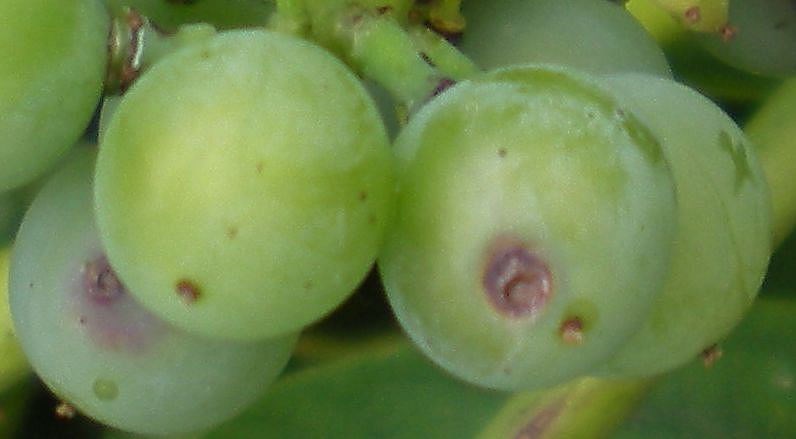
Grape berry moth (GBM) is a native North American pest that can reduce fruit quality both directly and indirectly. The immature or larval stage of the pest tunnels into fruit reducing fruit quality. The entry holes (“stings”) of the larve compromise the integrity of the berries and provide an entry point for assorted fruit rots including sour rot (Figure 1). There are three generations of GBM. The first generation of GBM appears around 400 cumulative degree days at a base temperature of 47 degrees F. The appearance of the first generation coincides with the bloom of wild grapes. Vineyards that have had consistent year to year problems managing GBM should manage this first generation. Since the emergence of the first generation of GBM coincides with wild grape bloom most of the GBM at this time will be in vineyard perimeters especially near wooded areas. Consider using a number of methods to monitor for the appearance of first generation GBM. Monitor wild grapes for bloom, calculate the number of growing degree days that have accumulated since April 1 at a base temperature of 47 degrees F and monitor the appearance of GBM using pheromone traps.
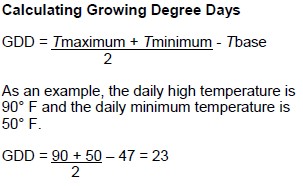
Get historical weather information from Missouri Mesonet weather stations. Select a weather station that is nearest your vineyard. Select average temperature for the period from April 1, 2022, to present day. Download the information (See page 4 for details) into an excel spreadsheet and subtract 47 from the average temperature for each day (Figure 2). Remember to correct the data that provides negative numbers to zero. Sum the degree days which is the cumulative degree days that have accumulated since April 1.
Before trying to manage the second or third generations of GBM, you need monitor temperatures, and also understand a bit about the biology of GBM. Rufus Isaacs at Michigan State University (MSU) has shown that GBM takes 810 and 1,620 GDD after wild grapes (Vitis riparia) bloom for the second and third generations, respectively to start egg laying. The biofix in this MSU model is the date in which wild grapes are flowering. Flowering is defined when 50% of the inflorescences have 50% of their flowers open. Typically wild grape blooms 8 to 14 days before most of the commercial grape cultivars bloom. Over the years a number of GBM models have been developed that use different biofix dates. For example, male GBM trap captures and degree day accumulations since April 1 and Jan. 1 are common. However, a biofix date based on grape phenology seems to be working more effectively.
Managing GBM
The first generation of grape berry moth typically appears in the vineyard at bloom. If your vineyard has been experiencing severe GBM damage consider applying an insecticide 10 days post bloom for control. The first generation of GBM is often more of a problem on the perimeter rows in the vineyard. Focus cover sprays on these perimeter rows especially perimeter rows that are along wooded areas. Second and third generation GBM can be managed by timing insecticide sprays based on the degree day model. Since the model predicts the egg laying of GBM, you have to consider your insecticide options. Altacor and Intrepid should be applied at 810 and 1620 GDD after bloom of wild grape. These insecticides need to be applied at the egg hatch or newly hatched larval stage of GBM. Both of these insecticides are considered reduced risk pesticides. Intrepid will only control Lepidopterous larvae and therefore will preserve natural enemies. Both Altacor and Intrepid have long residual control of GBM. If using broad-spectrum insecticides (Sevin XLR, Brigade or others), the insecticide should be applied at 910 and 1720 GDD after wild grape bloom. The latter applications of these broad-spectrum insecticides are targeting larva at various stages in their development.
Scouting and Monitoring for GBM
Pheromone traps should be placed in the vineyards in early April. There are a number of suppliers. Traps should be placed within the grape canopy. When placing traps make sure that adult moths have a direct path into the trap (Figure 3). Remove grape leaves or trim shoots that obstruct entry into the trap. Itis also important to monitor developing grape clusters for GBM damage. A telltale sign of a GBM damage are “stings” (Figure 4) White webbing with two or more berries webbed together (Figure 5). This webbing often has small specs of early instar GBM frass. On red berried cultivars another telltale sign of GBM is early coloration of the berries well before the onset of veraison (Figure 6). In addition, the first generation pupae of GBM will often be found on leaves in which the leaf edges have been rolled under by the larvae before pupation.
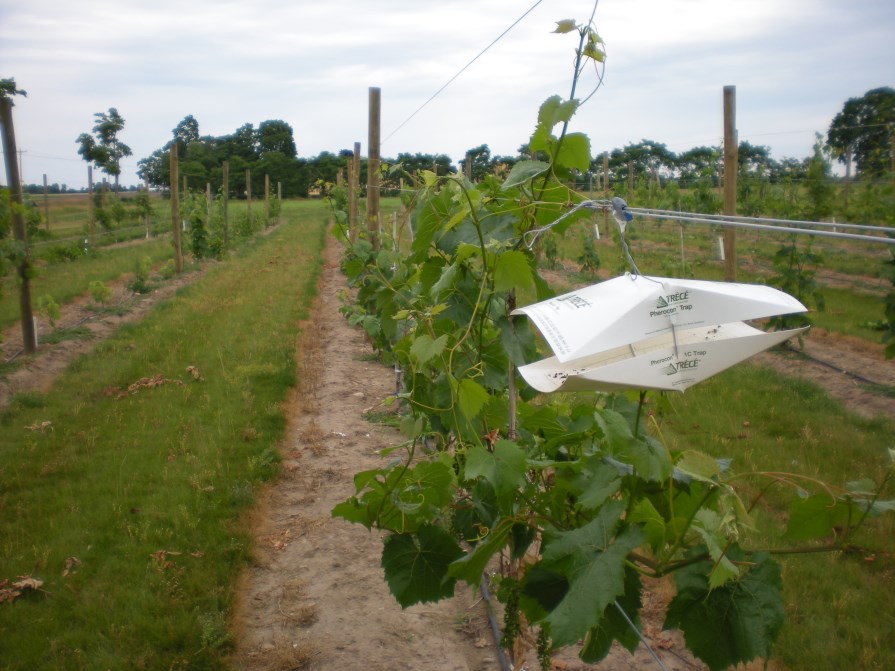
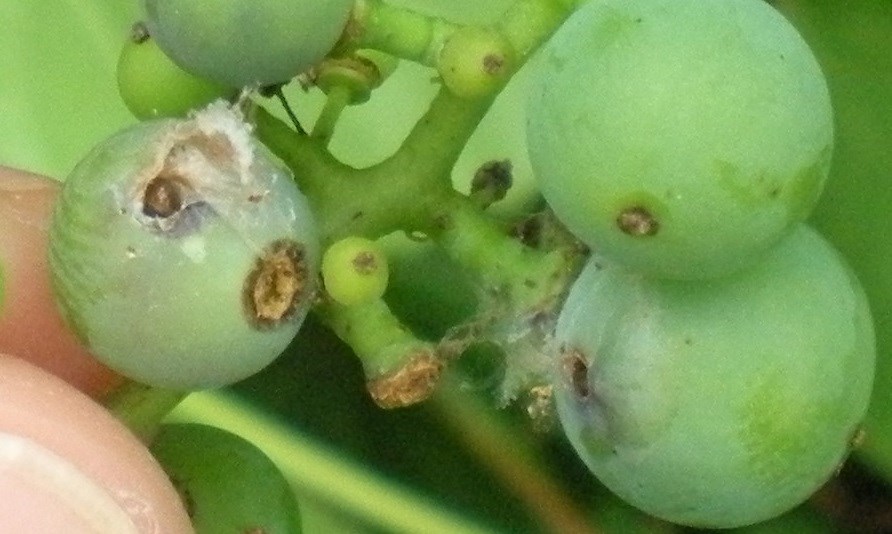
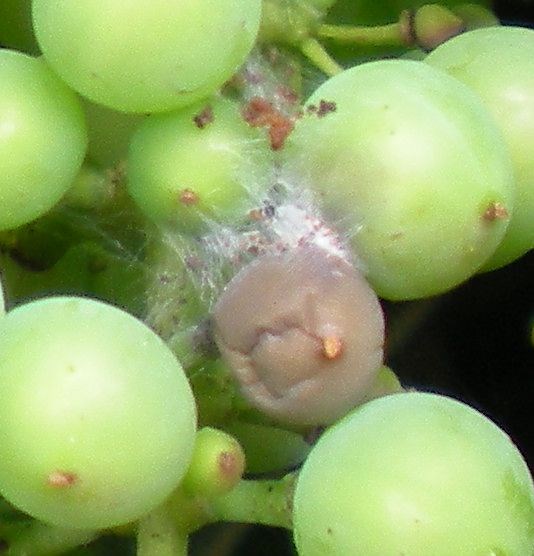
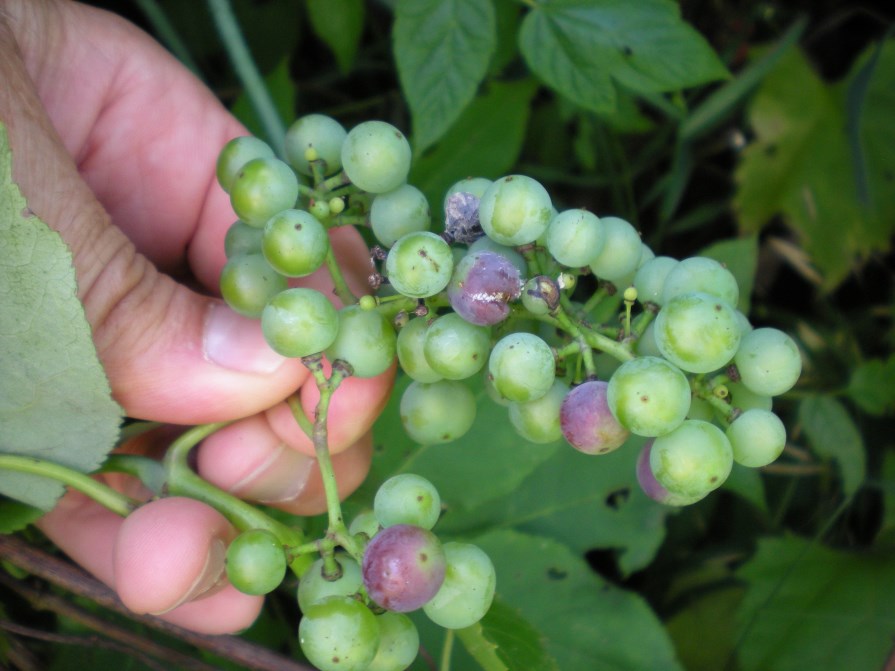
Quick Primer on Degree days and Development
Similar to plants, temperature is a driving force in the growth and development of insects. Before moving to insects, let's first look at grapes. In the last section of this report, I record the number of growing degree days that have accumulated at a base temperature of 50 degrees. The base temperature is the temperature at which no growth takes place. If the average daily temperature is 50 degrees or lower, no degree days accumulate and virtually no growth takes place. In addition to a lower base temperature threshold, often an upper limit temperature threshold is also used in which growth does not take place. In the case of most plants this upper limit is 86 degrees. If you can imagine, once the air temperature hits 86 degrees or above, the stomata's on the plant close and without gas exchange little or no photosynthesis is occurring and growth stops. Let's move onto insects where the same principles apply for growth and development. The major difference between insects and grapes is that the base temperatures are different. In fact, entomologists have determined the base temperatures for many insects. Some insect species have the same base temperatures but there is a significant range. It is very important that you use the correct base tempera-ture for the insect that you are trying to monitor. For grape berry moth, the base temperature id 47° F.
topHow to Get Data from Missouri Mesonet—Weather Station Network
- Bring up the Missouri Mesonet—Weather Station Network in your browser
- Select a weather station on the map that is near your vineyard
- Select the historical archive
- Change the starting date to April 1, 2022
- Change the end date to the current day
- On the available field elements select maximum air temperature and then hold down the shift key and also select minimum air temperature
- Select display results and you will see the data
How to get the data into an Excel spreadsheet
- Open up Excel and select a blank workbook
- Select the data tab
- Select Get data and from the drop down menu and select Legacy wizards
- A new web query box appears
- In the address box, select the default address and hit delete
- Now go back to your Mesonet data page and copy the URL, simply click on the URL and right click and select copy
- Paste the URL onto the address box of the new web query
- Select import and the data will appear in the new web query
- Select import again and a menu will ask you where in the excel workbook you would like the data to be imported, this defaults to $A$1
- Select OK and the data will appear in the Excel workbook page
How to manipulate the data to calculate GDD base 47
- Select an open cell to the right of the maximum and minimum temperatures starting with April 1
- Put your cursor into tho formula bar above the data
- Type = then select the maximum temperature + minimum temperature/2 -47
- The formula should read ((D14+E14)/2)-47
- Select the value in F14 and drag the box downward and all the values will be calculated for each date
- Copy this row of values and paste in the column to the right. Use paste special values only
- If negative numbers appear reset these values to zero
- Select the column of values
- Select the home tab and then Auto Sum
- The number that appears is the number of GDD base 47 that have accumulated since April 1
Selected Questions from Grape Growers
Question. Thoughts on when to apply Boron.
If either soil test results or petiole test results showed low Boron levels then corrections need to be made. Boron plays an important role in flower fertilization. Low Boron levels can result in low fruit set. If your soil analysis report shows low levels of Boron (below 0.4 ppm), be sure to also evaluate your soil pH value. If your soil is on the acidic side, then Boron will be readily available to the grapevines. However, you should consider correcting the Boron deficiency through foliar applications of Boron (Solubor 20.5%) or soil additions of Boron in the fall of the year. Soil additions of Boron this late in the growing season will not have time to penetrate the soil and leech into the grapevines root zone to have any impact. If petiole test results showed low Boron levels, then there a couple of ways to correct the deficiency. Research suggests that a fall foliar application of 1 lb of actual Boron per acre after harvest results in correcting the deficiency. In addition, a fall application of boron (after harvest) reduces the potential of phytotoxicity. Since this window of time has now passed, the alternative is to apply three to five applications, each application containing of 0.2 lbs Boron per acre starting prior to bloom through bloom. Never apply a foliar application of Boron containing more than 0.5 lb of Boron per acre or phytotoxicity will likely occur. Long-term management of Boron deficiency should involve soil testing followed by Boron additions to the soil. A basic recommendation is 1 lb actual Boron/acre/year. Ideally, soil applications should be applied in the fall to early winter. Fall and early winter rainfall events will result in moving the Boron into the soil. Care should be taken to never over apply Boron or phytotoxicity may result.
Question: Where can I obtain Heirloom Grape cultivars?
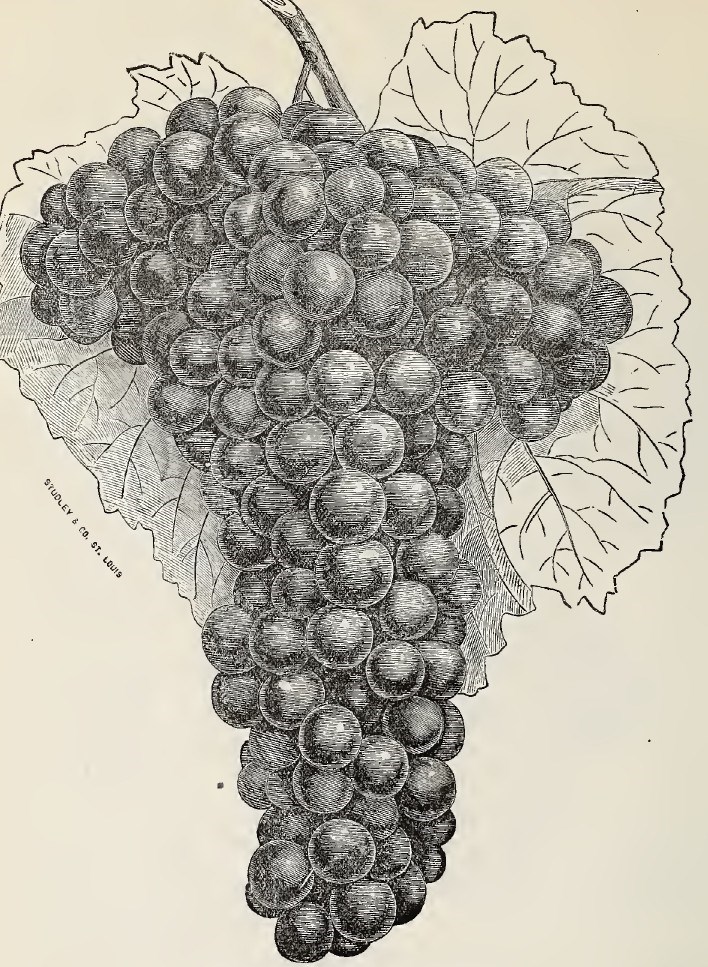
The most comprehensive list of old/heirloom grape that are still available would have been developed by Thomas Volney Munson. Some of these cultivars are available from Grayson College in Grayson, Texas. About 40 cultivars of T.V. Munson have been trialed in Missouri by Vox Vineyards just north of Kansas City. The grape cultivar Norton is the state grape of Missouri and has been grown in Missouri starting in the mid to late 1800s. Additionally, the cultivar Concord could be considered and old/heirloom cultivar.
The United States and Missouri especially lost a large number of grape cultivars during prohibition. The vineyards were destroyed and in the process a number of grape cultivars. Some of these old/heirloom cultivars were shipped to France during the Phylloxera epidemic and some of these heirloom cultivars still survive in France. One of these cultivars is Cunningham, which is currently in USDA quarantine and hopefully will be repatriated to the USA within the next few years (Figure 1).
Isidor Bush of Bushberg Vineyards and Grape Nurseries, Jefferson Co., Missouri, put out a nice descriptive catalog of grape cultivars available in 1880s. Sadly, few, if any, of these cultivars survived Prohibition. You can download the Bushberg catalog.
top
Please scout your vineyards on a regularly scheduled basis in an effort to manage problem pests. This report contains information on scouting reports from specific locations and may not reflect pest problems in your vineyard. If you would like more information on IPM in grapes, please contact Dean Volenberg at 573-882-0476 or 573-473-0374 (mobile) or volenbergd@missouri.edu
top